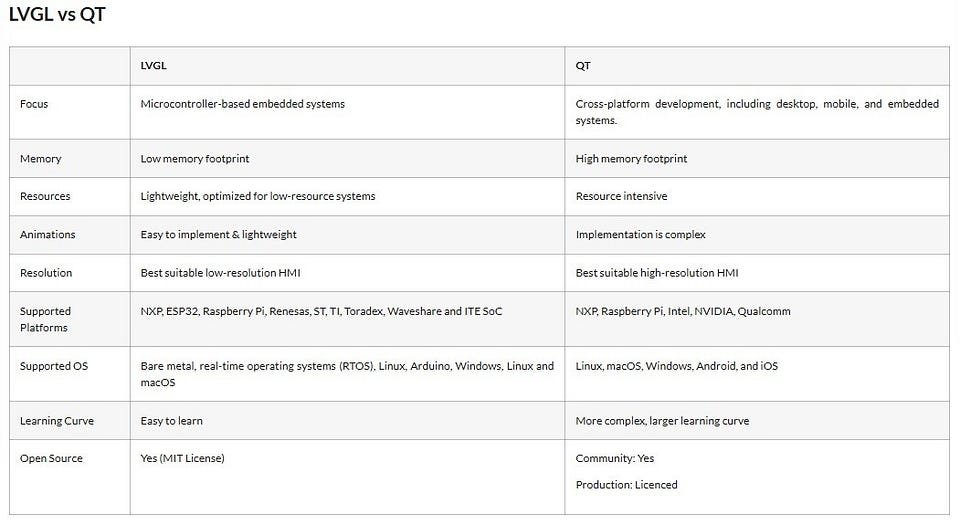LVGL: Redefining HMI Applications with Lightweight and Versatile Graphics
In the world of Human-Machine Interface (HMI) applications, the demand for intuitive, responsive, and visually appealing user interfaces has never been higher. As industries ranging from automotive to consumer electronics embrace smarter and more connected devices, the need for efficient and versatile graphics libraries has become paramount. Among the many options available, LVGL (Light and Versatile Graphics Library) has emerged as a game-changer, offering a lightweight yet powerful solution for creating modern graphical user interfaces (GUIs).

LVGL is an open-source graphics library designed specifically for embedded systems. Its lightweight architecture and versatility make it an ideal choice for resource-constrained devices, such as microcontrollers and low-power processors. Unlike traditional graphics libraries that often require significant computational resources, LVGL is optimized to deliver high performance even on devices with limited memory and processing power. This makes it a go-to solution for developers looking to create sleek and responsive HMIs without compromising on efficiency.
For a deeper understanding of LVGL and its applications in HMI design, you can explore this comprehensive guide on LVGL.
One of the standout features of LVGL is its modular design, which allows developers to customize and extend its functionality to suit their specific needs. Whether you’re designing a simple thermostat interface or a complex automotive dashboard, LVGL provides the flexibility to create tailored solutions. Its rich set of widgets, including buttons, sliders, charts, and text areas, enables developers to build interactive and user-friendly interfaces with ease. Additionally, LVGL supports advanced features such as animations, anti-aliasing, and multi-language text rendering, ensuring that your HMI not only functions well but also looks polished and professional.
Another key advantage of LVGL is its cross-platform compatibility. The library can run on a wide range of hardware platforms, from low-cost microcontrollers to high-performance application processors. This versatility is further enhanced by its support for multiple operating systems, including FreeRTOS, Zephyr, and Linux. By abstracting the hardware and operating system layers, LVGL allows developers to focus on designing the user interface without worrying about platform-specific details.
The integration of LVGL with modern development tools and frameworks is another factor contributing to its popularity. For instance, LVGL can be seamlessly integrated with popular IDEs such as Keil, IAR, and STM32CubeIDE, as well as with graphical design tools like Adobe XD and Sketch. This streamlines the development process, enabling designers and developers to collaborate more effectively and bring their ideas to life faster.
The latest trends in HMI design are also shaping the evolution of LVGL. One of the most significant trends is the growing emphasis on touch-based interfaces. As touchscreens become the standard for modern devices, LVGL’s support for multi-touch gestures and capacitive touch controllers makes it a perfect fit for creating intuitive and responsive touch-based HMIs.
Another emerging trend is the use of animations and transitions to enhance the user experience. LVGL’s built-in animation engine allows developers to create smooth and visually appealing transitions, such as sliding menus, fading effects, and dynamic charts. These animations not only make the interface more engaging but also provide visual cues that guide users through the application.
The integration of artificial intelligence (AI) and machine learning (ML) into HMI applications is also gaining traction. By combining LVGL with AI frameworks, developers can create intelligent interfaces that adapt to user behavior and provide personalized experiences. For example, an AI-powered HMI in a smart home system could learn a user’s preferences and adjust the interface accordingly, making it more intuitive and user-friendly.
As a leading provider of engineering and technology solutions, eInfochips is at the forefront of driving innovation in HMI design. With extensive experience in embedded systems, IoT, and software development, eInfochips leverages the power of LVGL to deliver cutting-edge HMI solutions for a wide range of industries.
eInfochips’ expertise in LVGL extends beyond basic implementation. The company offers end-to-end HMI development services, from concept design and prototyping to deployment and maintenance. By combining LVGL with advanced technologies such as AI, IoT, and cloud computing, eInfochips creates intelligent and connected HMIs that meet the evolving needs of its clients.
One of the key strengths of eInfochips is its ability to tailor LVGL-based solutions to the unique requirements of each project. Whether it’s optimizing the library for a specific hardware platform, integrating it with third-party tools, or adding custom features, eInfochips ensures that its clients get the most out of LVGL. This commitment to excellence has made eInfochips a trusted partner for companies looking to create innovative and high-quality HMIs.
In conclusion, LVGL is revolutionizing the way HMIs are designed and developed, offering a lightweight, versatile, and feature-rich solution for modern graphical user interfaces. Its ability to deliver high performance on resource-constrained devices, combined with its modular design and cross-platform compatibility, makes it a preferred choice for developers across industries.
As the demand for smarter and more connected devices continues to grow, LVGL is poised to play an increasingly important role in shaping the future of HMI design. By leveraging the expertise of industry leaders like eInfochips, developers can unlock the full potential of LVGL and create HMIs that are not only functional but also engaging and user-friendly.
Whether you’re designing an interface for a consumer device, an industrial control system, or an automotive application, LVGL provides the tools and flexibility you need to bring your vision to life. With its focus on efficiency, versatility, and innovation, LVGL is setting new standards for excellence in HMI design, paving the way for a more connected and interactive world.

Comments
Post a Comment